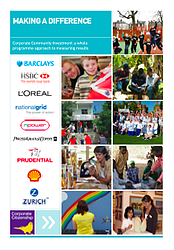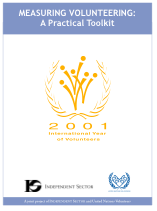Before the release of our Volunteerism ROI Tracker White Paper in collaboration with The Points of Light Institute, we reviewed a few of the existing resources for planning program evaluations. The following three reports provide guidance for measuring employee volunteer programs, each differing in audience, emphasis, and methodology.
Making a Difference
 Making a Difference: Corporate Community Investment, a Whole Programme Report to Measuring Results, reports on a six-month project, facilitated by Corporate Citizenship, to develop a consistent way of measuring the outputs and impacts of community investment projects.
Making a Difference: Corporate Community Investment, a Whole Programme Report to Measuring Results, reports on a six-month project, facilitated by Corporate Citizenship, to develop a consistent way of measuring the outputs and impacts of community investment projects.From their learning came a set of inputs and impact indicator groupings, supplied with an indicator checklist. The insight here is a shift from output indicators, like charitable donations given and people served, to metrics that capture outcomes. Indicators are measured base on a 5-point scale from no change to sustained change. Indicators include:
· Participant behavior and attitude
· Quality of life
· Skills and personal development
· Organizational capacity building
· Environmental measures
Another key take-away from the project was that mapping outcomes is as useful for project planning as it is for evaluating a program’s impact. Embedding metrics for measuring corporate citizenship into the initial stages of project development helped companies make goals explicit for progress monitoring.
The weakness of this report is that is almost entirely skips the final steps of program evaluation- defining a method, collecting and analyzing data, and integrating results into reporting. The report explores measuring impact without actually providing impact measurement solutions. However, assessment tools are available for LGB clients on their website.
Measuring the Difference Volunteers Make
The Minnesota Department of Human Services developed the Measuring the Difference Volunteers Make a decade ago, but it remains a readable and comprehensive resource for planning and implementing a volunteer program evaluation. Ideal for a company with the bandwidth to create an evaluation from scratch, the toolkit provides examples of how to define outcomes, compare data, and monetize the impact of volunteer efforts.
The toolkit outlines the following evaluation plan:
· Defining process indicators and outcomes of volunteer programs
· Types of evaluation
· Gathering data
· Survey techniques
· Communicating outcomes of volunteer programs
· Comparing results
Readers looking for examples of corporate employee volunteer program evaluations will be disappointed. While the examples are generally of state funded volunteer programs, they are illustrative of the same objectives, outcome measures, and performance indicators as an employee volunteer program. The toolkit even provides “good,” “better,” and “best” examples for writing program outcome statements. This toolkit offers the clearest content to help you develop tools for measuring CSR- with broad buy-in and a lot of elbow grease.
Measuring Volunteering Toolkit
 Measuring Volunteering Toolkit, released by United Nations Volunteers in collaboration with Independent Sector, is designed for an international audience seeking to measure volunteerism across an entire country. It offers multiple methodologies and survey approaches, along with a brief explanation of the principles of sound program evaluation- measurement validity and reliability, and sampling. Even for an initiative hiring an outside evaluator, this is key information for measuring and reporting on volunteer impact with confidence.
Measuring Volunteering Toolkit, released by United Nations Volunteers in collaboration with Independent Sector, is designed for an international audience seeking to measure volunteerism across an entire country. It offers multiple methodologies and survey approaches, along with a brief explanation of the principles of sound program evaluation- measurement validity and reliability, and sampling. Even for an initiative hiring an outside evaluator, this is key information for measuring and reporting on volunteer impact with confidence.
The Toolkit walks readers through an evaluation plan:
· Planning the research
· Designing the survey
· Problems of reliability and validity
· Collecting, processing, and disseminating the information
· Sample inventory of volunteering activities
The toolkit is not designed for employee volunteers, so it doesn’t provide examples or survey question suggestions that capture the business impacts of volunteerism, like employee engagement and commitment, the effect of volunteering on employee retention, or the PR and brand effects of volunteer programs. For those looking for an in-depth, step-by-step evaluation plan, the Measuring Volunteering Toolkit is a rich resource. But its scope is too broad for most readers, and its technical guidance may be overwhelming for practitioners without a research background.



